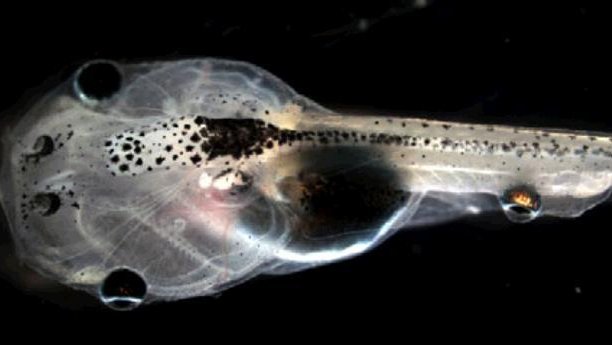The donor eye is visible on the underside of the tadpole's tail, right. (Douglas Blackison)
Blinded tadpoles were able to regain their site when scientists attached eyes to their tails.
A group of biologists at Tufts University surgically removed the eyes of 134 African clawed frog tadpoles and attached new ones on their tails. About half of the newly attached eyes grew nerve cells and successfully plugged into the spinal cord.
According to research published in the March issue of The Journal of Experimental Biology, research associate Douglas Blackiston and his supervisor Michael Levin were able to test the vision for the blinded tadpoles by bathing them in alternating blue and red light, while teaching them to associate the red light with a small jolt of electricity.
While the blind tadpoles showed no preference for the blue light, a few of the tadpoles with the donor eyes learned to stay in the "safe," blue-lit area.
The team had tested 134 tadpoles endowed with transplanted eyes, so what made these six tadpoles different? The answer lies in the nerve patterns extended by the donor eye after transplantation. Levin and Blackiston had cleverly used tadpoles expressing a red fluorescent protein as donors, and so they were able to see the pattern of red neurons extending from the new ectopic eye using a microscope. Half of the transplant patients showed no innervation. Of the remaining half, 26% showed neurons projecting from the donor eye towards the gut and 24% had neurons extending towards the spine. It was within this latter group that the six lucky tadpoles with colour vision fell.
"The brain is not wired to find an eye on the tail, since it's never happened before and thus is not something the brain has evolved specifically to deal with, and yet it can recognize this patch of tissue as providing valuable visual information," Levin said.
"These findings suggest that the brain has remarkable plasticity and may actually take a survey of its body configuration to make use of different body arrangements," he added. "If it were not the case, then every time a mutation produced an improvement in body plan--a large significant change in anatomy--the animal would die and the beneficial mutation would be lost."
Levin said the research could have major implications for replacing damaged organs in humans too, or even making them superhuman.
"Perhaps you'd like some more eyes, maybe ones that see in infrared?" Levin said--not entirely joking.







